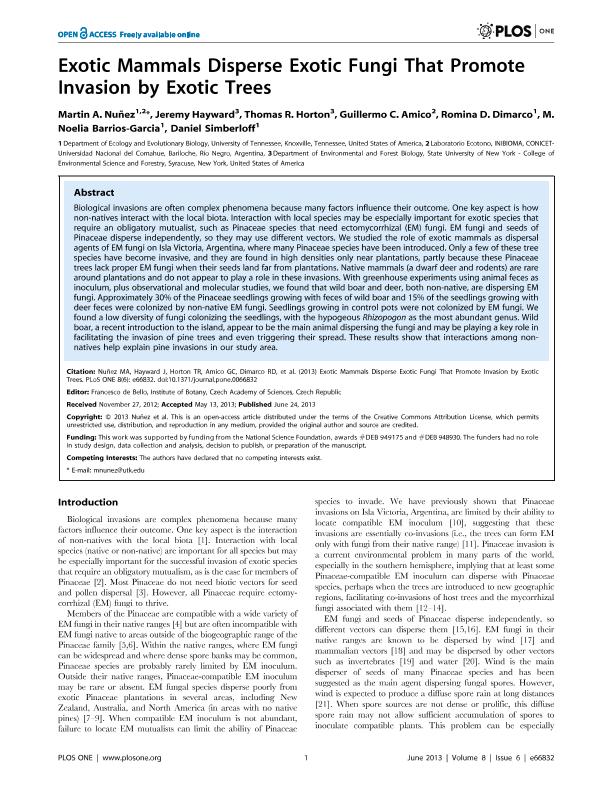Mostrar el registro sencillo del ítem
dc.contributor.author
Nuñez, Martin Andres

dc.contributor.author
Hayward, Jeremy
dc.contributor.author
Horton, Thomas R.
dc.contributor.author
Amico, Guillermo Cesar

dc.contributor.author
Dimarco, Romina Daniela

dc.contributor.author
Barrios Garcia, M. Noelia
dc.contributor.author
Simberloff, Daniel
dc.date.available
2016-07-28T18:16:38Z
dc.date.issued
2013-06
dc.identifier.citation
Nuñez, Martin Andres; Hayward, Jeremy; Horton, Thomas R.; Amico, Guillermo Cesar; Dimarco, Romina Daniela; et al.; Exotic Mammals Disperse Exotic Fungi That Promote Invasion by Exotic Trees; Public Library Of Science; Plos One; 8; 6; 6-2013; 66832-66832
dc.identifier.issn
1932-6203
dc.identifier.uri
http://hdl.handle.net/11336/6766
dc.description.abstract
Biological invasions are often complex phenomena because many factors influence their outcome. One key aspect is how non-natives interact with the local biota. Interaction with local species may be especially important for exotic species that require an obligatory mutualist, such as Pinaceae species that need ectomycorrhizal (EM) fungi. EM fungi and seeds of Pinaceae disperse independently, so they may use different vectors. We studied the role of exotic mammals as dispersal agents of EM fungi on Isla Victoria, Argentina, where many Pinaceae species have been introduced. Only a few of these tree species have become invasive, and they are found in high densities only near plantations, partly because these Pinaceae trees lack proper EM fungi when their seeds land far from plantations. Native mammals (a dwarf deer and rodents) are rare around plantations and do not appear to play a role in these invasions. With greenhouse experiments using animal feces as inoculum, plus observational and molecular studies, we found that wild boar and deer, both non-native, are dispersing EM fungi. Approximately 30% of the Pinaceae seedlings growing with feces of wild boar and 15% of the seedlings growing with deer feces were colonized by non-native EM fungi. Seedlings growing in control pots were not colonized by EM fungi. We found a low diversity of fungi colonizing the seedlings, with the hypogeous Rhizopogon as the most abundant genus. Wild boar, a recent introduction to the island, appear to be the main animal dispersing the fungi and may be playing a key role in facilitating the invasion of pine trees and even triggering their spread. These results show that interactions among non-natives help explain pine invasions in our study area.
dc.format
application/pdf
dc.language.iso
eng
dc.publisher
Public Library Of Science

dc.rights
info:eu-repo/semantics/openAccess
dc.rights.uri
https://creativecommons.org/licenses/by/2.5/ar/
dc.subject
Na
dc.subject.classification
Ecología

dc.subject.classification
Ciencias Biológicas

dc.subject.classification
CIENCIAS NATURALES Y EXACTAS

dc.title
Exotic Mammals Disperse Exotic Fungi That Promote Invasion by Exotic Trees
dc.type
info:eu-repo/semantics/article
dc.type
info:ar-repo/semantics/artículo
dc.type
info:eu-repo/semantics/publishedVersion
dc.date.updated
2015-09-30T19:16:49Z
dc.journal.volume
8
dc.journal.number
6
dc.journal.pagination
66832-66832
dc.journal.pais
Estados Unidos

dc.journal.ciudad
San Francisco
dc.description.fil
Fil: Nuñez, Martin Andres. University Of Tennessee; Estados Unidos; . Consejo Nacional de Investigaciones Científicas y Técnicas. Centro Científico Tecnológico Patagonia Norte. Instituto de Investigación en Biodiversidad y Medioambiente; Argentina
dc.description.fil
Fil: Hayward, Jeremy. State University Of New York; Estados Unidos
dc.description.fil
Fil: Horton, Thomas R.. State University Of New York; Estados Unidos
dc.description.fil
Fil: Amico, Guillermo Cesar. Consejo Nacional de Investigaciones Científicas y Técnicas. Centro Científico Tecnológico Patagonia Norte. Instituto de Investigación en Biodiversidad y Medioambiente; Argentina
dc.description.fil
Fil: Dimarco, Romina Daniela. University Of Tennessee; Estados Unidos;
dc.description.fil
Fil: Barrios Garcia, M. Noelia. University Of Tennessee; Estados Unidos
dc.description.fil
Fil: Simberloff, Daniel. University Of Tennessee; Estados Unidos;
dc.journal.title
Plos One

dc.relation.alternativeid
info:eu-repo/semantics/altIdentifier/url/http://journals.plos.org/plosone/article?id=10.1371/journal.pone.0066832
dc.relation.alternativeid
info:eu-repo/semantics/altIdentifier/url/http://www.ncbi.nlm.nih.gov/pmc/articles/PMC3691272/
dc.relation.alternativeid
info:eu-repo/semantics/altIdentifier/pmid/PMC3691272
dc.relation.alternativeid
info:eu-repo/semantics/altIdentifier/doi/10.1371/journal.pone.0066832
dc.relation.alternativeid
info:eu-repo/semantics/altIdentifier/doi/http://dx.doi.org/10.1371/journal.pone.0066832
Archivos asociados
